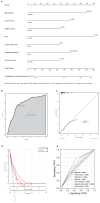A Nomogram Based on Preoperative Lab Tests, BMI, ICG-R15, and EHBF for the Prediction of Post-Hepatectomy Liver Failure in Patients with Hepatocellular Carcinoma
- PMID: 36615125
- PMCID: PMC9821206
- DOI: 10.3390/jcm12010324
A Nomogram Based on Preoperative Lab Tests, BMI, ICG-R15, and EHBF for the Prediction of Post-Hepatectomy Liver Failure in Patients with Hepatocellular Carcinoma
Abstract
Background: Liver cancer is one of the most common malignant tumors, and worldwide, its incidence ranks sixth, and its morality third. Post-hepatectomy liver failure (PHLF) is the leading cause of death in patients who have undergone liver resection. This retrospective study investigated the risk factors for PHLF by predicting and constructing an index to evaluate the risk. This was achieved by combining the lab tests with an indocyanine green (ICG) clearance test. Methods: The study analyzed 1081 hepatocellular carcinoma (HCC) patients who had received liver resection at Sun Yat-sen University Cancer Center between 2005 and 2020. The patients were divided into a PHLF group (n = 113) and a non-PHLF group (n = 968), according to the International Study Group of Liver Surgery (ISGLS) criteria. Receiver operating characteristics (ROC) curves were then used to estimate the optimal cut-off values. Univariate and multivariate logistic regression analyses were performed to identify the independent risk factors. Finally, a nomogram was constructed where the calibration plot, the areas under the ROC curve (AUC), and the decision curve analysis (DCA) showed good predictive ability. Results: Correlation analysis revealed that body mass index (BMI) was positively correlated with ICG-R15 and with effective hepatic blood flow (EHBF). Univariate and multivariate logistics regression analysis revealed that BMI, ICG-R15, international normalized ratio (INR), tumor size, hepatic inflow occlusion (HIO) time, and operation method were independent predictive factors for PHLF. When these factors and EHBF were included in the nomogram, the nomogram showed a good predictive value, with a C-index of 0.773 (95% Confidence Interval [CI]: 0.729-0.818). The INR had the largest ROC areas (AUC INR = 0.661). Among the variables, ICG-R15 (AUC ICG-R15 = 0.604) and EHBF (AUC EHBF = 0.609) also showed good predictive power. Conclusions: The risk of PHLF in HCC patients can be precisely predicted by this model prior to the operation. By integrating EHBF into the model, HCC patients at higher risk for PHLF can be identified more effectively.
Keywords: ICG clearance test; ICG-R15; body mass index; effective hepatic blood flow; post-hepatectomy liver failure.
Conflict of interest statement
The authors declare no conflict of interest.
Figures



References
-
- Cai J., Chen L., Zhang Z., Zhang X., Lu X., Liu W., Shi G., Ge Y., Gao P., Yang Y., et al. Genome-wide mapping of 5-hydroxymethylcytosines in circulating cell-free DNA as a non-invasive approach for early detection of hepatocellular carcinoma. Gut. 2019;68:2195–2205. doi: 10.1136/gutjnl-2019-318882. - DOI - PMC - PubMed
-
- Poon R.T., Fan S.T., Lo C.M., Liu C.L., Lam C.M., Yuen W.K., Yeung C., Wong J. Improving perioperative outcome expands the role of hepatectomy in management of benign and malignant hepatobiliary diseases: Analysis of 1222 consecutive patients from a prospective database. Ann. Surg. 2004;240:698–708. doi: 10.1097/01.sla.0000141195.66155.0c. - DOI - PMC - PubMed
LinkOut - more resources
Full Text Sources
Miscellaneous

